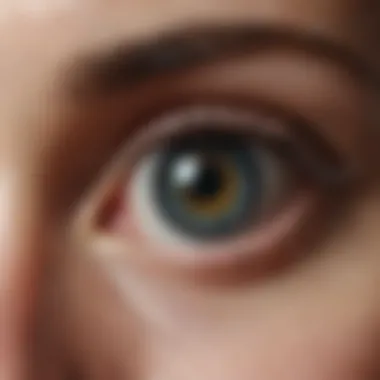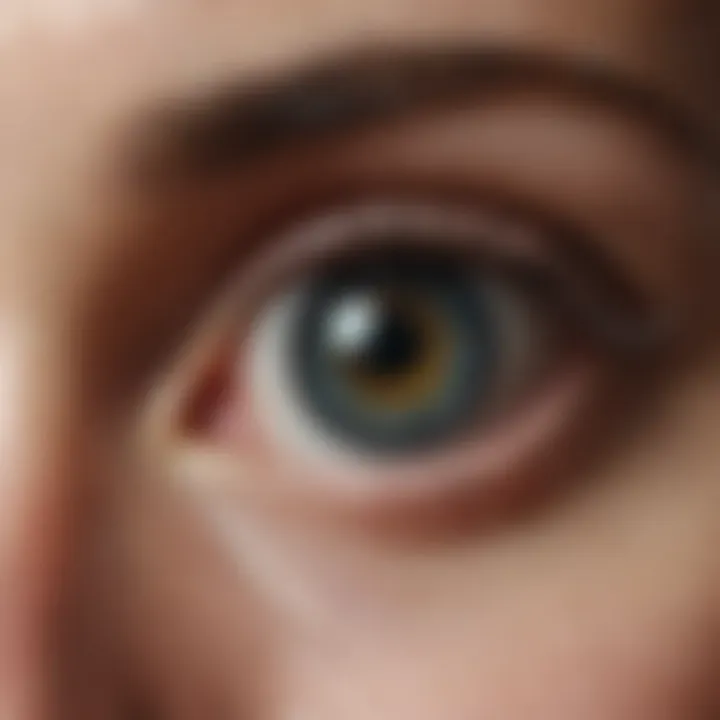Understanding Eye Genetics: An In-Depth Exploration


Intro
This exploration into eye genetics seeks to unravel the complexity surrounding how our genes influence eye traits and disorders. As a multifaceted subject, it encompasses the genetic basis of characteristics like eye color, the hereditary nature of vision disorders, and the ongoing advancements in gene therapy. Understanding these elements is crucial for both researchers and practitioners in ophthalmology, as eye genetics continuously shapes clinical practices and future research directions.
Research Overview
The field of eye genetics has witnessed significant progress over the last few decades. Geneticists, ophthalmologists, and researchers are now able to decode the layers of heredity that govern ocular health.
Key Findings
Multiple studies indicate that a variety of genes contribute to eye color, including OCA2 and HERC2. These genes interact in complex ways, leading to the diverse range of eye colors seen in the human population. Vision disorders, too, stem from genetic underpinnings; conditions such as retinitis pigmentosa and age-related macular degeneration often show a strong hereditary component. Recent investigations have also highlighted the potential for gene therapy to rectify genetic defects affecting vision, offering hope for effective treatments.
Study Methodology
To arrive at these findings, researchers commonly employ techniques like whole-genome sequencing and genetic linkage analysis. These methodologies help in identifying specific genetic markers linked to ocular traits. For instance, researchers analyze family pedigrees to observe inheritance patterns of certain eye disorders, allowing them to pinpoint which alleles correlate with specific conditions.
Background and Context
Understanding eye genetics requires a grasp of both historical precedents and current trends.
Historical Background
The journey into eye genetics can be traced back to early studies in the 20th century, where scientists began to elucidate the hereditary nature of various eye conditions. Over time, innovations in genetic mapping transformed our understanding, leading to the identification of specific genes associated with visual traits. This foundational work paved the way for modern genetic research focused on the eye.
Current Trends in the Field
Currently, the integration of genomic technologies is reshaping how we understand eye diseases. New tools, such as CRISPR-Cas9, enable precise editing of genetic materials, offering pathways to potential cures. There is also a rising interest in how the environment interacts with genetic factors, shedding light on complex conditions that were previously thought to be purely genetic.
"The future of eye genetics lies in marrying genotypic insights with phenotypic realities to create holistic treatment strategies."
In essence, as we continue to explore eye genetics, it becomes clear that the connection between our genes and our visual health is intricate and profound.
Preface to Eye Genetics
Definition and Scope
Eye genetics refers to the study of the inherited characteristics that influence the structure and function of the eye. This area of genetics encompasses a range of traits, from eye color to the predisposition for various ocular conditions. Parsing out the complex interplay between genetics and ocular health is essential for understanding why certain individuals may be more susceptible to specific disorders such as glaucoma or macular degeneration. Given the intricate anatomy and diverse functionality of the eye, eye genetics offers a significant field for exploration. It delves into how variations in specific genes can lead to notable differences in visual capabilities and susceptibility to diseases.
Importance of Studying Eye Genetics
The way we understand and treat eye health today relies heavily on insights from eye genetics. Studying eye genetics is important for several reasons:
- Medical Advancements: Knowledge in this area leads to better screening methods for early detection of hereditary eye disorders.
- Personalized Treatment: Understanding genetic predispositions can result in customized treatment plans that cater to individual needs.
- Public Health Insights: Genetic studies contribute to broader epidemiological insights, helping to understand patterns of ocular diseases across different populations.
As the field advances, integrating genetic data into clinical practice becomes increasingly vital. For those involved in healthcare and research, this understanding translates to improved therapeutic strategies and potentially better health outcomes for patients.
Genetic Basis of Eye Color
Understanding the genetic basis of eye color is essential for comprehending not only how this trait is inherited but also its implications in ophthalmic science. The interplay between various genes results in the multitude of eye colors observed in the human population. This section delves into the mechanisms that drive eye color variation, shedding light on the specific roles of melanin production and key genetic players involved in this process.
Melanin Production and Eye Color
Melanin is the pigment that gives color to our eyes, skin, and hair. There are two primary types of melanin relevant to eye color: eumelanin and pheomelanin. Eumelanin is present in higher concentrations in darker eyes, while pheomelanin contributes to lighter shades. The amount and distribution of these pigments determine the resulting eye color. Specifically, brown eyes result from a high concentration of eumelanin, whereas blue eyes are due to lower levels of the pigment combined with structural color variations.
When melanin is produced in the eye’s iris, it entails complex biochemical pathways influenced by genetics. Understanding these pathways can unlock insights into not just cosmetic traits but also potential links to eye health issues, reinforcing the importance of melanin in ocular biology.
Key Genes Involved
Several genes play critical roles in determining eye color. Below are three prominent genes that significantly contribute to this trait:


ODF3B Gene
The ODF3B gene is known for its involvement in spermatogenesis and possibly in ocular traits. Its specific contribution to eye color, while less defined than others, is involved in pigmentation pathways. A notable characteristic of ODF3B is that it is located on the X chromosome, making it an interesting aspect from a hereditary perspective.
Its importance in this article lies in recognizing the multifactorial aspects of eye color genetics. The ODF3B gene may not be the direct influencer of pigmentation but is part of the broader genetic landscape that influences how traits are expressed.
HERC2 Gene
The HERC2 gene plays a crucial role in eye color variation. It acts as a regulator for the OCA2 gene, which is directly tied to melanin production. The common variant of the HERC2 gene, known to interact with OCA2, can predict blue versus brown eye coloration. The prominent aspect of HERC2 is its clear genetic linkage to pigmentation traits, making it a key focus for researchers.
The appeal of the HERC2 gene is due to its distinct mechanism of influencing eye color directly through its regulatory role, unlike ODF3B. This makes it a beneficial subject of discussion for geneticists and ophthalmologists alike.
TYR Gene
The TYR gene is vital for the production of the enzyme tyrosinase, which initiates the melanin synthesis process. Without proper functioning of this gene, melanin production becomes impaired, potentially leading to conditions like albinism where eye color is drastically affected.
The TYR gene is essential not only for its role in determining eye color but also for its broader implications in health. Its significance in this article is highlighted by the essentiality of melanin in visual function and protection from UV radiation, adding a layer of importance in studies of both eye health and genetics.
Variability of Eye Color Across Populations
Eye color varies significantly across different populations and regions. This variability is influenced by a combination of genetic diversity and environmental factors. In some populations, such as those in northern Europe, lighter eye colors are more prevalent, possibly due to historical adaptation to lower light conditions.
In contrast, regions closer to the equator typically have populations with darker eyes, likely due to increased melanin providing a protective advantage against UV radiation. This section highlights the interaction between genes and environment, providing further insight into the complexities of human evolution and adaptation.
Understanding genetic diversity in eye color through these lenses not only fosters appreciation for human biology but also reinforces the essential role genetics plays in defining hereditary traits.
Hereditary Eye Disorders
Hereditary eye disorders represent a crucial area of study within the realm of eye genetics. Understanding these disorders allows researchers and medical professionals to explore the genetic underpinnings of various ocular conditions. This knowledge leads to better diagnostic techniques and potential treatment options for affected individuals. There are several genetic eye disorders that are commonly observed, each with specific characteristics and implications.
Common Genetic Eye Disorders
Retinitis Pigmentosa
Retinitis pigmentosa is a group of genetic disorders that cause progressive degeneration of the retina. This condition is characterized by the loss of peripheral vision followed by central vision loss. Its contribution to the field of eye genetics is significant due to its complex inheritance patterns. Moreover, it serves as an essential model for understanding the mechanisms of retinal degeneration. The key feature is the gradual loss of photoreceptors, which are critical for vision. This disorder is a beneficial choice for this article because it underscores the importance of genetic factors in vision loss. Also, it highlights advancements in gene therapies which offer promise in reversing some effects.
Color Blindness
Color blindness, or color vision deficiency, affects the ability to perceive colors accurately. This condition often results from genetic mutations that impede the function of photoreceptors in the retina. The condition contributes valuable insight into the genetics of ocular traits. The primary characteristic of color blindness is the difficulty in distinguishing between certain colors, usually red and green. This disorder is useful for this article as it elucidates the implications of X-linked inheritance. A unique feature is that many individuals with color blindness adapt and develop coping mechanisms. However, it remains a disadvantage for those in situations requiring accurate color discrimination.
Cataracts
Cataracts are characterized by the clouding of the eye's natural lens, leading to decreased vision. They are often related to aging but can have hereditary components as well. Their contribution to the overall goal of this article is substantial as they encompass both genetic predispositions and environmental factors. The key characteristic is that cataracts can be detected early, often through routine eye exams. This makes cataracts a relevant topic, as both prevention and management strategies are largely based on genetic understanding. A unique aspect is that cataracts can often be surgically treated, offering hope for restoring vision to affected individuals.
Mode of Inheritance
The mode of inheritance plays a crucial role in understanding how hereditary eye disorders are passed from one generation to the next. Various patterns exist, each impacting the likelihood of developing eye disorders. These patterns also influence the genetic testing available, offering insights into family risk assessments.
Autosomal Dominant
Autosomal dominant conditions occur when only one copy of a mutated gene is sufficient to cause the disorder. This is a vital aspect as it implies that affected individuals have a 50% chance of passing the condition to their offspring. The key characteristic is that symptoms can present in every generation. This makes it beneficial for the article because it emphasizes how hereditary conditions can have immediate familial impacts. A unique feature is the variability in expressivity among individuals, which can lead to differing severity of symptoms within a family.
Autosomal Recessive
In contrast to autosomal dominant inheritance, autosomal recessive disorders require both copies of a mutated gene for the condition to manifest. This pattern is significant in understanding genetic eye disorders, as carriers may be asymptomatic. The key characteristic is that affected individuals typically inherit the mutation from both parents. This condition’s relevance lies in the variability of carrier status within populations. A unique aspect is that even if both parents are carriers, the probability of having an affected child is still only 25%. This makes it essential to consider genetic counseling in families with a history of such disorders.
X-Linked Inheritance
X-linked inheritance refers to genetic conditions related to genes on the X chromosome. This mode of inheritance is primarily significant for conditions like color blindness and certain retinal dystrophies. The key characteristic is that males are more severely affected than females due to their single X chromosome. This aspect is beneficial for the article, as it highlights disparities in how different genders experience genetic eye disorders. A unique feature is the role of carrier females, who may pass the mutation while remaining unaffected. Understanding this can influence genetic testing and counseling strategies for families.
The Role of Environmental Factors


Understanding the role of environmental factors in eye genetics is crucial. Genetics is not the sole determinant of ocular health and characteristics. The interplay between genes and environmental influencers can significantly shape traits such as eye color and susceptibility to eye disorders. This section explores how external conditions impact genetic expression and what this means for individuals.
Gene-Environment Interactions
Gene-environment interactions (GEIs) involve the ways in which genetic predispositions are modified by environmental exposures. For example, sunlight exposure can enhance the risk of developing certain eye conditions. People with lighter eye colors may be more sensitive to bright light. Their genetic predisposition interacts with the intensity and duration of UV exposure, influencing their overall eye health.
This interaction is not limited to light exposure. Other factors play a role as well:
- Nutritional Elements: Deficiencies in vitamins A, C, and E can lead to serious vision problems, despite one's genetic makeup. Thus, environmental nutrition must be considered.
- Pollution and Toxins: Studies show that exposure to air pollution may be linked to increased risks of developing cataracts and other degenerative eye conditions.
In summary, understanding GEIs is vital for predicting risks and creating tailored interventions to maintain ocular health. Moreover, it emphasizes the complexity of genetic expression, revealing that genetics alone does not dictate outcomes.
Impact of Lifestyle on Genetic Expression
Lifestyle choices also play a significant role in how genes related to eye health are expressed. This includes various aspects such as diet, exercise, and habits:
- Diet: A diet rich in leafy greens and colorful fruits can provide antioxidants that support eye health. Conversely, excessively high sugar intake contributes to the development of diabetic retinopathy, demonstrating how lifestyle directly affects conditions linked to genetics.
- Physical Activity: Regular exercise can improve blood circulation, which is crucial for eye health. It may reduce risks for conditions like glaucoma and macular degeneration.
- Smoking and Alcohol Use: Both are known risk factors for cataracts and age-related macular degeneration. Genetic predispositions may be exacerbated by these harmful habits.
The understanding of how lifestyle impacts genetic expression is fundamental, not only for prevention but also for treatment strategies. By integrating knowledge from genetics and lifestyle, a more holistic approach to eye care can be developed.
By acknowledging the interplay of environmental factors, healthcare professionals can offer more personalized and effective eye care solutions, enhancing patient outcomes.
Advancements in Genetic Research
Understanding the advancements in genetic research is crucial in the broader context of eye genetics. These developments pave the way for more effective diagnosis, treatment, and prevention of eye diseases. Specifically, the integration of cutting-edge technologies into research has enhanced our capacity to identify genetic markers associated with various ocular conditions. Furthermore, innovations like gene therapy and precise gene editing hold promise for treating previously untreatable hereditary eye disorders.
Techniques in Ophthalmic Genetics
Whole Genome Sequencing
Whole genome sequencing is a method that involves determining the complete DNA sequence of an organism's genome. This technique allows researchers to analyze variations in genetic coding that could contribute to eye-related conditions. One key characteristic of whole genome sequencing is its ability to detect both common and rare genetic variations simultaneously. This makes it a powerful tool for uncovering the complexities of genetic diseases.
A unique feature of whole genome sequencing is its comprehensive nature, which provides a full overview of an individual's genetic material. The advantages include pinpointing genetic disorders and understanding disease mechanisms. However, it can also lead to overwhelming amounts of data that require careful interpretation, which can complicate the research process.
CRISPR Technology
CRISPR technology revolutionizes gene editing by allowing precise modifications to DNA. This technique offers the potential to correct genetic mutations responsible for eye disorders, thus contributing directly to the goals of ocular health. The key characteristic of CRISPR is its efficiency and accuracy, making it a favorable choice for researchers.
A notable unique feature of CRISPR is its ability to create targeted edits in the genome without affecting surrounding genetic material. The advantages of using CRISPR include the potential for effective therapies and the capacity to study gene function in real-time. Nonetheless, ethical considerations arise regarding gene editing, such as unintended consequences in the genome.
Gene Mapping
Gene mapping focuses on identifying the locations of genes within chromosomes. This process is vital for understanding the genetic basis of eye traits and disorders. The key characteristic of gene mapping is its emphasis on the relationships among genes and their corresponding phenotypes. In the context of eye genetics, it helps identify associated risks for certain conditions.
A significant feature of gene mapping is its capability to clarify how specific genes contribute to eye health. The advantages include identifying genetic predispositions, which can inform treatment options and preventive measures. However, it often involves complex data that requires considerable expertise to interpret accurately.
Gene Therapy Applications
Current Treatments
Current treatments in gene therapy focus on correcting genetic defects that lead to eye diseases. This innovative approach allows for targeted intervention. A key characteristic of these treatments is their tailored nature, addressing specific genetic issues. Current therapies represent a favorable choice as they can modify the underlying genetic problems rather than just addressing the symptoms of eye conditions.
The unique feature of current treatments involves the delivery of corrected genes to the cells through various vectors, aiming to restore normal function. One advantage is their potential effectiveness in treating conditions that were previously incurable. However, limitations still exist, including the need for further research to determine long-term safety and success rates.
Future Prospects
Future prospects in gene therapy represent a significant area of advancement. The continued exploration of innovative treatment methods, including next-generation sequencing and advanced delivery systems, shows promise for enhancing therapies for hereditary eye disorders. A key characteristic is the focus on individualized treatment plans, as researchers increasingly tailor therapies to specific genetic profiles.
The unique feature of these prospects lies in their potential for developing sustainable and efficient treatment options for patients. Advantages include the possibility of preventative strategies and long-term treatments. However, challenges remain, particularly regarding the ethical implications and accessibility of these therapies, which must be addressed moving forward.
"The ongoing advancements in eye genetics offer a beacon of hope for those affected by hereditary conditions, signaling a future where genetics may dictate treatment and preventions, rather than only the disease itself."


By analyzing these aspects of advancements in genetic research, we gain deeper insights into the complex field of eye genetics and the potential for improved ocular health in the future.
Ethics in Eye Genetics Research
The subject of ethics in eye genetics research is crucial to understanding how genetic advancements affect society. As researchers delve deeper into the genetic foundations of eye diseases and traits, ethical considerations become more prominent. These concerns can shape how research is conducted, how findings are applied in clinical settings, and the societal ramifications of genetic information.
Ethical Considerations in Genetic Testing
Genetic testing in ophthalmology raises several ethical issues. First, the privacy of patients must be considered. Individuals' genetic information is highly sensitive. Maintaining confidentiality is essential to protect personal data. Breaches in privacy not only harm patients but can also lead to discrimination by employers or insurance companies.
Additionally, there is the matter of informed consent. Patients should fully understand the implications of genetic testing before participating. They need to know what information will be derived from the tests and how this will be used. It is crucial that researchers and healthcare providers communicate transparently about potential outcomes and risks associated with genetic analysis.
Also, the possibility of incidental findings must be addressed. When genetic tests reveal information unrelated to the initial purpose, patients may face difficult choices. It is important to establish guidelines on how these findings should be communicated and whether patients want such information revealed.
Implications of Genetic Information
The implications of genetic information in ophthalmology are extensive and multifaceted. The ability to predict eye diseases based on genetic markers can revolutionize patient care. Early detection can lead to timely interventions, potentially preventing vision loss. However, this prospect comes with responsibilities.
There are concerns about how genetic information is used within society. Ethical dilemmas arise when considering how such knowledge affects family dynamics or identity. For example, if one family member carries a genetic risk factor for a disorder, it raises questions for the rest of the family regarding testing and treatment decisions.
Furthermore, there exists a risk of stigmatization for individuals with certain genetic predispositions. Public awareness is vital to mitigate misunderstandings about genetic risks. Promoting genetic literacy can help society appreciate the nuances of genetics rather than resorting to stereotypes or biases.
Genetic information can reshape our understanding of health, transforming both the prevention and treatment of eye diseases. Care must be taken to navigate the complex ethical landscape that arises alongside these advancements.
Future Directions in Eye Genetics
The field of eye genetics is undergoing rapid transformation, significantly reshaping our understanding of ocular health and disease. With ongoing studies and advancements, it offers promising insights into how genetic variations can influence eye-related traits and disorders. Addressing this topic in detail is crucial, as the implications of emerging research can expand knowledge horizons and facilitate novel treatment approaches.
Emerging Research Trends
Several trends stand out in the realm of eye genetic research today. One area of growth is the increasing utilization of high-throughput sequencing technologies. These technologies enhance the ability to identify novel genetic variants linked to ocular conditions. Notably, whole genome sequencing allows researchers to analyze vast genetic data and discover previously overlooked mutations. This method not only boosts diagnostic accuracy but also aids in tailoring specific treatment options.
Additionally, the integration of artificial intelligence (AI) is proving to be a valuable tool. AI systems are being implemented to analyze imaging data, providing insights that manually reviewing images might miss. Deep learning algorithms can identify disease patterns and enhance early detection of eye disorders, improving patient outcomes significantly.
Furthermore, initiatives like the All of Us Research Program aim to gather diverse genetic information that reflects the general population. This inclusivity is vital for understanding how variations across different ethnicities affect eye health.
"Research trends indicate a significant shift towards personalized approaches in understanding eye disorders, highlighting the need for further studies in diverse populations."
Personalized Medicine in Ophthalmology
Personalized medicine is transforming ophthalmology remarkably. By recognizing the unique genetic makeup of individuals, clinicians can customize treatment plans that effectively address specific conditions. This paradigm shift is particularly relevant for hereditary eye disorders, such as retinitis pigmentosa and Stargardt disease. In these cases, genetic testing identifies mutations that may inform prognosis and treatment options.
Moreover, gene therapy is at the forefront of personalized medicine in eye genetics. Techniques like CRISPR can potentially correct genetic defects at the cellular level, offering hope for conditions that were previously untreatable. Several clinical trials are currently evaluating the efficacy of gene therapy in restoring vision or slowing down disease progression.
Ultimately, as research continues to evolve, personalized medicine will likely play a pivotal role in managing eye health. By focusing on individual genetic profiles, healthcare providers can develop targeted interventions that optimize patient care and enhance quality of life.
In summary, the future of eye genetics appears to be promising and multifaceted. Emerging research trends and advancements in personalized medicine are set to redefine diagnostics and therapeutics in ophthalmology, emphasizing the delicate interplay between genetics and ocular health.
End
In understanding eye genetics, it is crucial to encapsulate the range of insights covered in this article. The intricate nature of eye genetics provides a lens through which we can appreciate the complex interplay of heredity and environment in shaping ocular health and traits. Eye genetics holds significance not just for researchers, but also for clinicians and patients. Recognizing the genetic basis of specific eye colors, hereditary disorders, and the promise of gene therapy offers potential pathways to better treatment strategies and personalization of medicine.
Summary of Key Insights
The exploration of eye genetics reveals several key insights:
- Genetic Factors: Eye color and various vision disorders stem from specific genetic components, as demonstrated by the role of genes like ODF3B, HERC2, and TYR.
- Hereditary Disorders: Understanding modes of inheritance, such as autosomal dominant and recessive patterns, is fundamental in identifying predispositions to conditions like retinitis pigmentosa and color blindness.
- Environmental Factors: Environmental influences can modulate genetic expression, impacting the development and progression of eye conditions.
- Advancements in Research: Techniques such as whole genome sequencing and CRISPR technology represent the cutting edge of ophthalmic genetic research and its application in treatments.
By summarizing this information, we gain a clearer perspective on how eye genetics can influence both individual health and broader public health strategies.
The Importance of Ongoing Research
The field of eye genetics is rapidly evolving. It represents a confluence of genetic science and clinical practice with pressing implications for future healthcare. Ongoing research is vital for numerous reasons:
- Advancement in Treatments: As gene therapies develop, the potential to treat genetic eye disorders will grow, reducing the burden on individuals affected by these conditions.
- Broader Understanding: Each new study contributes to a comprehensive understanding of how genetic variants influence eye diseases, facilitating preventive measures and improved diagnostics.
- Personalized Medicine: The quest for personalized treatment plans based on genetic makeup is paramount. Continuous research ensures that therapies can be tailored to individual genetic profiles, leading to more effective outcomes.
In summary, ongoing research in eye genetics not only enhances our understanding but also holds the promise of preventative and therapeutic advancements in ophthalmology, benefiting future generations.







